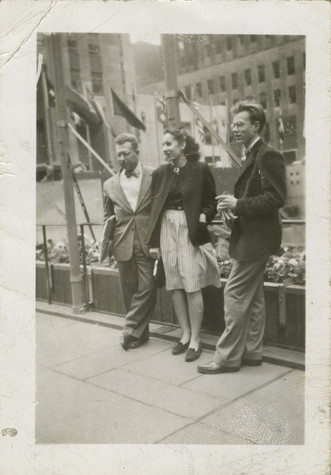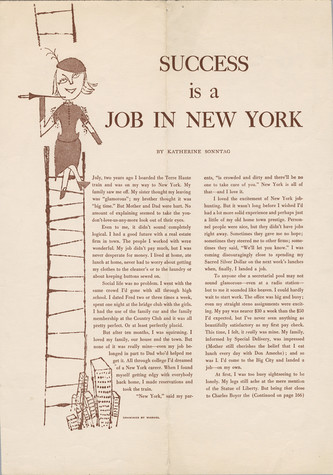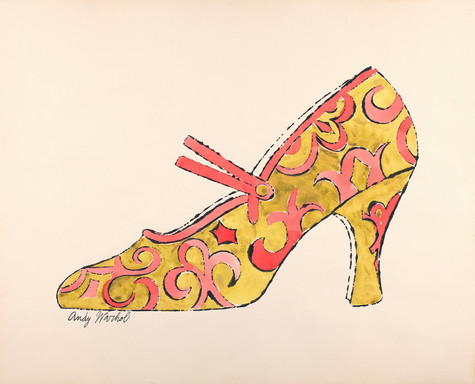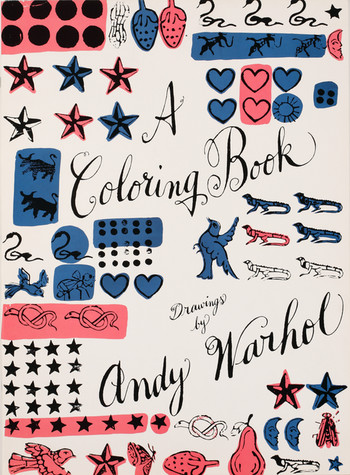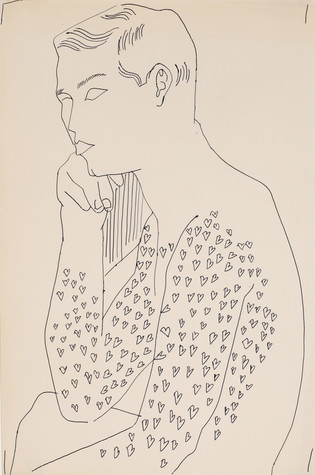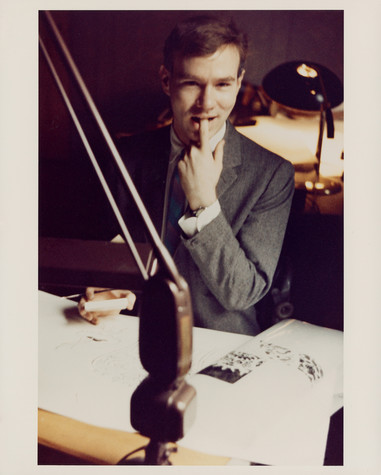1950s
After graduating from art school with a degree in pictorial design, Warhol moved to New York City to pursue a career as a commercial artist, and he dropped the final “a” in Warhola. He moved with fellow classmate Philip Pearlstein and created a circle of close-knit friends including college friend Leila Davies Singeles and dancer Francesca Boas. His work first appeared in a 1949 issue of Glamour magazine, in which he illustrated a story called “What is Success?” An award-winning illustrator throughout the 1950s, some of his clients included Tiffany & Co., I. Miller Shoes, Fleming-Joffe, Bonwit Teller, Columbia Records, and Vogue.
Warhol was known for his blotted-line ink drawings, using a process he developed in college and refined in the 1950s. This working method combined drawing with basic printmaking and allowed Warhol to repeat an image and to create multiple illustrations along a similar theme. He could also make color or compositional changes quickly in response to client requests.
In 1952, Julia Warhola moved to New York City to live with her son. Julia was an artist in her own right. Cats and angels were her favorite things to illustrate, and in 1957 Warhol published a book of her drawings, Holy Cats by Andy Warhol’s Mother. Warhol enlisted her to add her feminine and delicate penmanship to hundreds of his drawings, including advertisements, album covers, and book illustrations.
Warhol self-published a large series of artist’s books in the 1950s. He would hold parties at Serendipity 3, a restaurant and ice cream parlor on Manhattan’s Upper East Side, where his friends would help him hand color his books. In 1956, he presented a solo exhibition at the Bodley Gallery called Studies for a Boy Book. These sketchbook drawings of portraits of young men and erotic portrayals of male nudes contrasted with the work of other contemporary gay artists, such as Robert Rauschenberg and Jasper Johns, who considered Warhol “too swish.”
Sexuality
In the early 1950s, many of Warhol’s friends and fellow artists were accepted to show at the Tanager Gallery in New York City, but the works he submitted were rejected because of their subject matter—two men embracing. Warhol was a gay man, and homosexuality was criminalized in 1950s America. Warhol filled sketchbooks in the 1950s with drawings titled Boy Portraits, which were loving, humorous depictions of the male form and studies of feet, torsos, and genitalia. During his foray into film in the 1960s, Warhol did not shy away from sexuality. His films included scenes of sexual escapades, explicit and not—from turning tricks to sleeping. One of Warhol’s earliest films featured his then-boyfriend, poet John Giorno, sleeping nude in the nearly six-hour-long Sleep (1963). Throughout his career, Warhol blurred the lines between his romantic and professional relationships, mixing business and pleasure. Edward Wallowitch, Ted Carey, John Giorno, Jed Johnson, and Jon Gould were some of Warhol’s business associates with whom he also had intimate relationships. He returned to the male—and female—nude in the 1970s with his Sex Parts and Torso series. In the 1980s, Warhol’s focus on the body in his work and return to hand painting corresponded with the early days of the HIV/AIDS public health crisis, which devastated New York City’s arts scene and gay community.
Entrepreneur
As equally as he was an artist, Warhol was an entrepreneur. He kickstarted his career in the 1950s as a commercial illustrator, earning a sizeable revenue to finance his artistic ventures. Warhol grew up during the rise of post-war consumer culture in the U.S. and England and realized the benefit of assembly lines in manufacturing, employing studio assistants and processes to aid his artistic production. Warhol successfully balanced commercial and entrepreneurial endeavors with avant-garde, underground work. He continually pushed himself to experiment in new media—publishing, film, music production, television, fashion, theater—throughout his career and frequently collaborated with artists and brands. Warhol wrote in THEPhilosophy of Andy Warhol (From A to B and Back Again), “Being good in business is the most fascinating kind of art. Making money is art and working is art and good business is the best art.”
